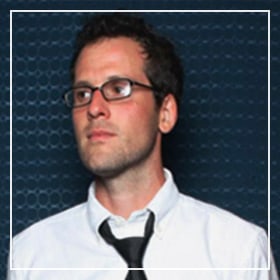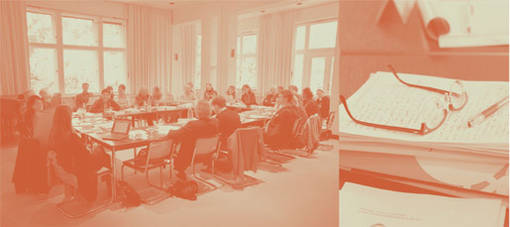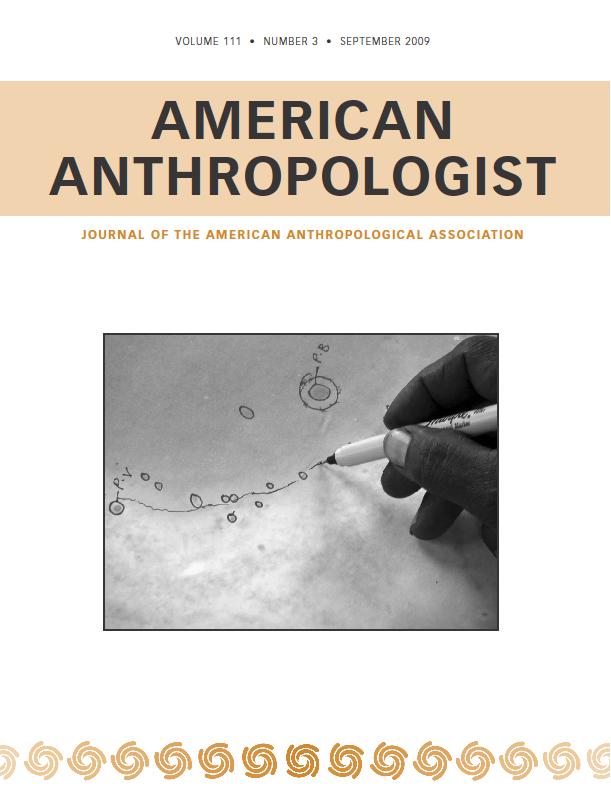In a fit of ambition, I attended or spoke at five academic conferences in the humanities and social sciences during the spring 2016 semester. Discipline specificity and conference themes were rather diverse, ranging from radical archaeology, the anthropology of color, queer circuitry, anarcho-theology, and media poetics. A pervasive theme ran through each though. From hour-long keynote addresses by established scholars to fifteen-minute presentations from graduate students, there was persistent reliance upon a scientific lens to buttress the methodology and conclusions being discussed.
I’d like to interrogate the genealogy of this ‘scientific lens’, and suggest that its foundations lie in a joke that social scholarship is (wittingly or not) playing on itself.
I was once told that dissecting a joke is like dissecting a frog: sure you’ll understand how it works, but you’ll kill it in the process. Well, this joke died a long time ago, and I’m merely attempting an autopsy.
At a conference on ancient technology art historians, theologians, and archaeologists came together to expound upon the mechanics through which archaic populations were able to achieve various technological feats. Much less emphasis was placed upon the meaning of ancient technologies, their role in social organization, or why such technological acuity was deemed valuable by its practitioners. Similarly, a student anthropology conference on aesthetics focused more on chemistry, botany, and physics than social dynamics. Of foremost concern were the oxidation process of rust, neurological sleep diagrams (polysomnograms if you’re interested), robust debates distinguishing silviculture from viticulture, and perhaps most obscenely my own efforts to articulate the mathematics behind linear perspective and the construction of two-dimensional reality.
Perhaps this trend is not worthy of observation. Rigorous scholars should rely on the most widely accepted research to help guide their interpretations? Oddly though, the ‘scientific lens’ being employed at these conferences represents precisely the method of investigation that has been thoroughly undressed by Science & Technology Studies, most notably the ubiquitous work of Bruno Latour and the criminally less-cited Donna Haraway. Ironically, nearly all the scholars utilizing this scientific approach to validate their arguments are explicit or implicit adherents to Haraway’s or Latour’s notions of agency (human and non) and the socio-politically mediated contours of knowledge production.
A peculiar dissonance has thus arisen within the current materialist-realist enthusiasm, in which the social scholars are pantomiming a mockery of science, with the unintended effect of reproducing its authoritative claims.
Latour and Haraway’s brilliance is in undercutting science’s claims to producing objective ontological facts about the universe, highlighting the systemic oppression these claims can manifest. Both achieve this, to one extent or the other, through emphasizing non-human agency. Plenty has been written about this ‘the material turn’ and the renewed interest in objects and things. Different scholars have venerated their own champions of this trend (Arjun Appadurai’s Social Life of Things, Tim Ingold’s work on materiality, or Pierre Lemonnier’s work on technology are often cited). While it’s not my intent to argue strongly for this, the current rhetoric very directly takes its cues from Haraway and Latour. Thus, examining the specific work of these two scholars underscores the paradox of the current material moment.
Latour’s work questions the unfettered access that Science is granted in understanding and producing Nature (the non-human, non-cultural), arguing that appeals to ‘the nature of things’ aborts the socio-political contingency of knowledge production. He cautions against a simple inversion of anthropocentricism with nature-centricism (trading the notion that humans are the center of causality for the idea that everything not-human is the center of causality). For her part, Haraway has demonstrated the extent to which ‘nature’ is a politically exploited concept used to justify relations of domination, specifically through invoking alleged observations of competitive hierarchies within non-human primate communities. Her work undermines teleological notions of human social organization that are founded upon (inaccurate and narrow) interpretations of non-human interaction. Both see ‘nature’ as a political tool of domination and science as the architecture of this ‘nature’.
Through Haraway and Latour’s revitalization of non-human agency they undermine scientific claims of producing ‘real’ (not culturally biased) knowledge about causal mechanics. Subsequent scholars have been eager to consider the affordances and affective capacities of the non-human, challenging the logic that the non-human is some reservoir of reality from which science can elicit explanations for the social realm.
The irony is that the language scholars have found most expedient for these considerations comes from the same scientific vantage that Latour and Haraway’s work was meant to disrupt.
That is, anthropologists invoke non-human agency to discredit the authority of science, while at the same time employing science to nuance and support their appreciation for non-human agency. If this is a joke, who is in on it? And where’s the punchline?
In both conferences and articles there seems to be an implicit agreement that the material turn necessitates some cursory account of a techno-scientific procedure explaining the physical capacities of one’s chosen object of examination – fermentation, nuclear reactions, combustion, pollination, etc. This performance is meant to embolden the agency of materials, pointing out that our surrounding objects are not passive receptacles of human intention. The underlying sentiment here appears to be, ‘hey let’s pretend to be scientists for a couple minutes to make fun of their ridiculous claims to objectivity’.
But somewhere the humor got lost, and social scholars became entranced by the methodical inhumanity of scientific knowledge’s probabilistic reliability. The belief motivating the perpetuation of this humor-less joke is that the non-human is best appreciated by observing its material causative properties, i.e., its most reliably predictable effects. Neglected in this belief is that the methods of observing such causative properties are socio-politically designed. We don’t gain a better appreciation for the non-human on its own terms by invoking the techno-capital machinery that observes reality as a quantitative probabilistic output. Scientific knowledge is in no way less human, just because it strains to eliminate the subjective from its observations. This is exactly what Latour and Haraway have demonstrated.

*****
Can the material turn be less reliant upon scientific knowledge production? The fear is that describing non-human interaction in humanistic terms (i.e., biased by emotion or subjectivity) precludes an appreciation of the non-human on its own terms, again suggesting that science is a less human form of knowledge production than, say, poetry. Surely, though, when a bee interacts with a flower’s stamen the two actants don’t base their engagement upon the scientifically observed principles of pollination. Such principles ex post facto describe a probabilistic outcome of the interaction of these two actants, but the signal the bee receives from stamen is not coded in such language.
To be sure, we do not have access to bee-centric receptivity to signals (See Charles Peirce’s triadic information processing for background on my use of signals here, or more accessibly Pauline Couper’s work on Fluvial Semiotics). A social scientist trying to describe the bee-stamen interaction in scientific terms is a cheap effort to occlude our inalienable ignorance of bee-centric realities (see Timothy Morton’s Hyperobjects for more nuanced discussions of anthropocentricism or wind-centricism or tree-centricism).
Instead of such efforts to gloss over our ignorance, would it be unthinkable to accept an absence of knowledge? Can we not play with the innate inability of the human machine to reconstruct the point-of-view of the bee (or any object)? Rather than filling this requisite void with a cursory recitation of science, can such lacunae be integrated into our interpretative approach? A methodological question, for example, may be, ‘how does population Z respond to the impossibility of experiencing the bee-stamen interaction. Different populations respond differently to such gulfs of reconciliation. My population, for instance, navigates the lacuna of appreciation for a bee’s experience of a stamen by describing it through formulae of reproduction, chemical optics, photosynthesis, and evolution.
To move anthropology forward from simply mimicking scientific discourse, a new approach is needed to engage the inhuman.
A study of non-human agency’s role in social dynamics is intrinsically a study of how populations respond to ignorance, how populations respond to the unknowable. A working definition of ‘non-human’ may be ‘that which is alien’ or ‘that which is unknowable’.
When a mathematician sees a phrase like ‘3x = 6’ they try to ‘solve for X’ – the unknown. I’d suggest that rather than ‘solving for X’ or explaining away the unknown, the social scholar concerned with the agency of the inhuman examine the effect of X upon the 3 and the 6, i.e., how does being connected through an unknown entity condition the relationship of 3 and 6? The prerogative of social scholarship should be to investigate how populations negotiate the abyss between knowable and unknowable, not to follow science’s efforts to fortify this breach in knowledge.
*****
Why has social scholarship been seduced by this scientific approach? Old insecurities about our data and conclusions not being rigorous enough (for NSF funding particularly)?
This sentiment’s been pretty well put to bed. I would rather suggest that scientific mythology has been enrolled in a trending discursive technique, which I would sheepishly dub the podcastration of knowledge. This entails corralling disparate peripheral understandings into narratives of economic, political, spiritual, or environmental behavior. Granted, fifteen minute talks lend themselves to the punchy intravenous information congenital to the podcast, but published papers in journals have been following a similar script.
Thanks largely to the efforts of Latour and Haraway, scientific knowledge has been exposed as disposable, interchangeable, mass-producible. Science talk has converged with PR-marketing speak. Is a pharmaceutical ad science-talk or marketing-talk? Listening to presentation after presentation at social science conferences explain thermodynamics, phosphorous isotopes, cell division, or electric circuitry begins to sound like one of those indecipherable advertisements that try to sell you three things at once, cross-promoting an app, a movie, and fast food chain. This scientific lens is the public relations arm of capitalized knowledge, reassuring us that the world is deterministic, understandable, and controllable.
This revelation is both liberatory and dangerous: liberatory in that it diminishes the idolatry of science, but dangerous in that it conflates ‘reality’ with marketing.
Social scholars know that the ‘reality’ that science observes can be employed to reify inequitable social relations. Anthropology’s great strength is in challenging the normative, questioning the taken-for-granted. By reciting received wisdom from science regarding the chemical relationship between bees and flowers are anthropologists complicit in reproducing asymmetrical distributions of power? Perhaps so, but I’d suggest this brand of scholarship is more inspired an unconscious mimesis than a critical unawareness.
Academics of considerable wit and deviance, I think it’s rather possible that Latour and Haraway brandished the terminology of science with a knowing, defiant smirk. Mimicking scientific discourse offered an air of, ‘this science stuff isn’t so hard, it’s not some inaccessible locked away knowledge that we could never penetrate’. But as this satire became repeated more and more the defiant smirk eroded and the enrollment of science to appreciate non-human agency became the fashion, as opposed to the liberation of non-human agency from hegemony of scientific ‘reality’.
Combusting science’s illusion of impenetrability has been one of anthropology and sociology’s most valiant and useful undertakings. It is very important to expose the myth that scientific modes of knowledge production are inaccessible to the layperson. Thus, it is not my concern to outright condemn the enrollment of science. I just want to ‘notice it’. Conceding domains of knowledge to their producers is precisely how calamities like the 2008 financial crisis are perpetrated. We were told the math, algorithms, and computational physics used to repackage worthless loans into valued assets was too complicated for laypeople to comprehend. Turns out, it wasn’t that complicated. Advanced, complex math was used in the actuarial accounting of risk diffusion, but ultimately it was revealed that such calculations, while perhaps accurate on their own terms, did not reflect any underlying reality. As most knowledge production is, the math was based on assumptions. For a while these assumptions held, then over time, things changed (as they will), and they no longer applied. The mathematical conclusions were just as ‘wrong’ as those of an archaeologist who misidentifies the use of some artifact, which is to say not ‘wrong’ at all, simply the product of contingent observational methodology.
Yet, the work of anthropology is not the work of policing or following science.
The scientific impetus upon producing ‘right / wrong’ or ‘true / false’ interpretations of causal behavior demonstrates the larger dangers of incorporating this form of knowledge production into anthropology’s engagement with the non-human. The financiers’ equations weren’t calculated incorrectly (one assumes they double checked the numbers and all that), rather their very construction was designed to elicit a pre-determined meaning. They certainly were not applying some ontological understanding of the workings of finance, risk, or economic behavior. Rather they were designing an apparatus of observation that allowed them to engineer the knowledge needed to justify the exploitation of debt and debtors (See Karen Barad’s work on measurement and observation).
Social scientists do this too. We all do. Every observation, be it that of an anthropologist, mathematician, chemist, bird, cat, or cactus has a point of view, has a contingent history which nuances how it receives signals from other actants. Humans or historians are not special in the inability to appreciate the vantage of non-human materials. Birds are incapable of appreciating the vantage of non-birds. Stones are incapable of appreciating the experience of non-stone (See Graham Harman’s democratic critique of Kant’s inability to know the ‘thing-in-itself’).
Harman has derided Dan Dennett’s idea that the pretentiousness of wine criticism can be replaced by deterministic machines that synthesize and analyze a wine’s chemical composition. Yes, it’s certainly enticing to mock the arcane adjectives of wine critics (earthy, ashen, windblown aftertaste), but neither a scientifico-determinist account or pretentious verbiage are more or less ‘real’ descriptions of the experience of wine as a culmination of the interaction of grapes, barrels, dirt, nitrogen, a vintner’s hands, bottles, and glasses. We can’t translate the grape’s central nervous system into our own, but we can describe how and why humans engage with this inability, engage with this intrinsic absence of knowledge. A grape has an endless reserve of affordances to which we will never have access. One way to confront the unknowability of grapes is to make them alcoholic, to intoxicate the void. Another manner of tracing unknowable voids of experience is with humor, thus a pantomimesis of scientific pretensions to parsing reality is perfectly useful, but we must remember not to let the humor fall into the void.
Works Cited
Appadurai, Arjun. 1986. The social life of things: Commodities in cultural perspective. Cambridge: Cambridge University Press.
Barad, Karen. 2007. Meeting the universe halfway: Quantum physics and the entanglement of matter and meaning. Durham: Duke University Press.
Couper, Pauline. 2007. Fluvial geomorphology and semiotics: A Wittgensteinian perspective of the ‘divide’ between human and physical geography. Transactions of the Institute of British Geographers. 32(3): 279-94.
Haraway, Donna. 1991. Simians, cyborgs, and women: The reinvention of nature. New York: Routledge.
Harman, Graham. 2010. Towards speculative realism: Essays and lectures. Winchester, UK: Zero Books.
Ingold, Tim. 1987. The appropriation of nature: Essays on human ecology and social relations. Iowa City: University of Iowa Press.
Latour, Bruno. 1987. Science in action: How to follow scientists and engineers through society. Cambridge, MA: Harvard University Press.
Latour, Bruno. 2004. Politics of nature: how to bring the sciences into democracy. Cambridge, MA: Harvard University Press.
Lemonnier, Pierre. 1993. Technological choices: Transformation in material cultures since the Neolithic. London; New York: Routledge.
Peirce, Charles S. 1998. The essential Peirce selected philosophical writings. vol. 2. Bloomington: Indiana University Press.
Featured image from Internet Book Archive Images (Public Domain)






It would be interesting to take into account the work of Isabelle Stengers, in Cosmopolitics I and II, for example.